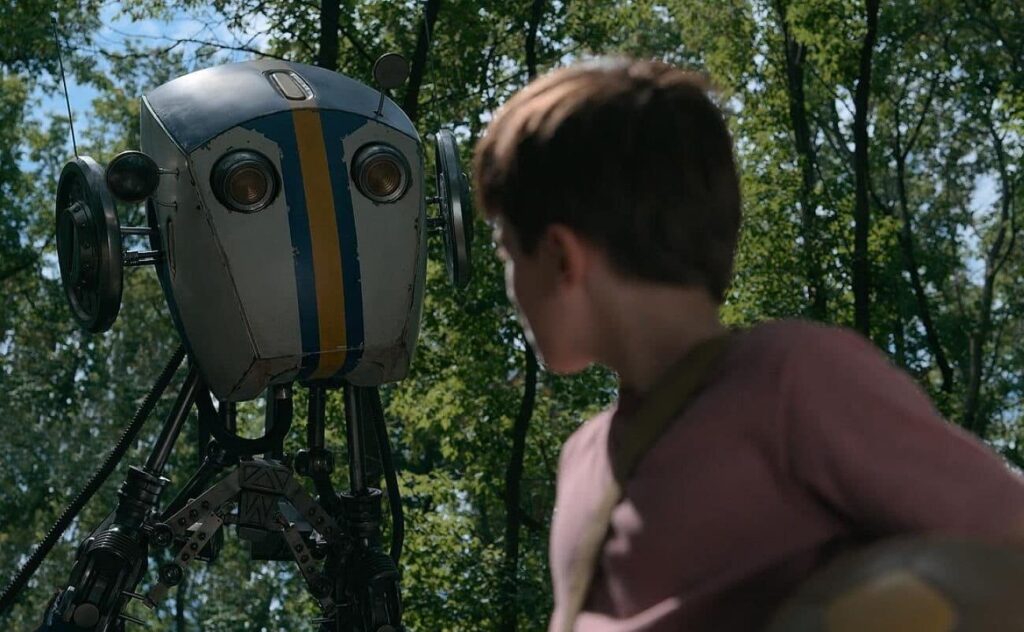The Electric State
Simon Stålenhag
Skybound books, $35 (paper)
Tales From the Loop
Simon Stålenhag
Skybound books, $39.99 (paper)
Tales from the Loop (Season 1)
Amazon Studios
Memory, rich as it is, has its closures and exclusions. Few, if any, can remember the constant wars of the late 1980s and ’90s in the American West: the vast tech armies now rusting away, the ghost towns and cities, the ruination that the great war machines caused. And so many of the war’s survivors addicted to the “neurocasters” that serve as refuge from the real world.
Swedish artist and author Simon Stålenhag has made these memories, shown them, dreamed them. Stålenhag creates picture books for adults, and his story album The Electric State (2018) is as rich in striking full-page pictures as his story is spare. A young woman, Michelle; her mother dead; her father and his feeble girlfriend completely taken up by their neurocasters. Michelle intends to set out into the “electric state” with her beloved AI, little Skip, who resembles a long-gone Howdy Doody. She goes toward Pacifica, through the wasted lands, Mojave, the Blackwelt badlands, to San Francisco Memorial City and the sea. Michelle’s digressions—of anger, fear, grief, wonder—take up the spaces arrived at or passed through, even if these can’t change the obdurate vacancy and waste.
A common mode in current science fiction is the Alternate History: pasts that could have happened instead of what did. To me, “alternate history” suggests a history that alternates, goes back and forth between premises. The term “alternative history” is common also, but restricts the game to just one remade past. In The Electric State, Stålenhag does neither: there’s no sense of a former, more familiar world that this strange land has arisen from, no land or nation that can be remembered.
In the course of her journey, Michelle stays a night with her father Ted and his girlfriend Birgitte in a motel pressed up against a monstrous machine from which taut cables run and tiny lights flicker in the ever-present fog of dust. In the morning they find Birgitte at the bottom of the pool, “her waterlogged body heavy like a marble statue against the tiles, the LEDs on her neurocaster still burning like glowing embers.”
Walking away from the motel, Michelle discovers an abandoned Oldsmobile four-door, the former owners lying quietly beside the car, each head encased in a neurocaster. She finds the car keys in the dead man’s pocket. Skip climbs into the back seat. Her last car, she figures, till she reaches the Pacific.
The old war in the barren West precedes her. She doesn’t concern herself with who fought whom, but the collapsed equipment and huge installations everywhere show how much damage was done. Tattered SENTRE billboards still announce new weapons: “Winning Design Awards. And Wars.” Most are far gone in rust, ripped apart by scrappers, sinking into desert sand; many are products of SENTRE. Its signs, ambiguous but pervasive, unable to be decoded by an outsider, peel from the bodies of awesome, silent, immobile weapons. (The motto of SENTRE is “Stay Connected”).
The neurocasters are the most puzzling and least explained of all Stålenhag’s dark devices. The front flash page of The Electric State is a garish ad for the SENTRE Mode Six neurocaster: “A new experience arrives—01.11.1996.” A cartoon figure wreathed in ribbons and multicolored lightning bolts wears the new device. How does it work? What does it provide? Michelle in the Olds crosses a dark river where people wearing neuros walk the night; in her old home, she’d “been awakened early in the mornings by similar crowds, shuffling along the streets in silent confusion—uneasy, nocturnal animals on their way back to their dens and burrows.” Now, crossing Carson Pass and past a huge spherical SENTRE installation, she knows what she sees. “I guess there must have been millions of minds bouncing around inside that thing, and the power required to please them melted the snow.” Which is as much as we learn of the casters’ lives and obsessions; they belong to a near-dead world.
Dante, in his journey to the underworld, passing through the horrors and cruelty of the Inferno, comes upon the souls of giant beings from a former world. Some speak, tell their stories; all they can do is talk and suffer, fall silent or rage. The dreaming, dark, impenetrable America Stålenhag creates in The Electric State is that place too.
His earlier book, Tales from the Loop (2015), however, is quite—though not entirely—different: set in a quiet, forested, underpopulated, seemingly Edenic world of family, love, kindness, and grief—though the search for and the deploying of power goes on here as well.
“Construction of the Facility of High-Energy Physics, commonly called the Loop, was a vast particle accelerator and research facility, drawing on the power of the earth’s magnetic fields, was newly exploited in the 1960s,” Stålenhag writes. “It provided power to enormous airships like MS Ancylus, one of the first magnetrine ships with a single turbine. . . . Always present on the horizon were the colossal cooling towers of the Bona reactor, with their green obstacle lights.”
Amazon Prime began a miniseries based on Tales from the Loop in the spring of 2020: the first eight episodes are called Season One, though it seems there will be no Season Two, no continuation. To followers of the series, this lapse may seem oddly proper: all that can be told has been told. The show’s settings and characters are mostly not taken from the Scandinavia of Stålenhag’s book; they seem instead to be Americans in some Main Street decade of the last century, where boys build tube radios, girls wear skirt-and-sweater sets, teachers are gentle and wise; they all speak a plain Midwestern English. Beneath their feet, where most adults work daylong, is the titanic Loop, running endlessly, far below them. The neurocasters of Electric State don’t appear in this gentler and more stable place; neurocasters can only belong to a near-dead world.
Some viewers of the series may find that the odd fairy-tale aspects of the series seem almost like impositions on otherwise plain, carefully concrete stories. Bodies and souls change place in a sort of solemn Alice in Wonderland quadrille, in which brothers switch selves and girls are also their mothers. But these aspects of the show are not impositions from producer/creator Nathaniel Halpern or Amazon Studios: all the strange reversals, the shifting of generations, ghosts in the machines, are Stålenhag’s own.
As in The Electric State, this landscape is littered with discarded hardware, apparently useless; but two young teens have learned that an abandoned steel pod still functions. The boys enter the utter blackness of the sphere—and once outside again, find that they have switched bodies. This is at first funny to them, then weird (no one else can discern the other in the boy they know), and finally dreadful. Jakob (Daniel Zohlgadri) returns to the sphere to end the strangeness, and—disappears. His young brother Cole (Duncan Joiner) is devastated, and searches hopelessly for him—until a tall, scarred, ungainly robot shyly approaches “his” house, only to flee. When Cole begins to understand that the robot is his brother, he sets out to find him—as others in Tales from the Loop set out to find truths and face fears. In a tangled wood—at once threatening and kind—Cole watches a fierce battle between a Loop guardian robot and another robot—Jakob, who is destroyed. The image of Cole cradling the metal face and battered head of his brother is at once weird and deeply touching.
That strangeness—magic and impossibility, alongside mechanical giants—is also at the heart of Michelle’s journeys in The Electric State. Late in that story we learn that she has a brother who was born with serious cognitive and physical impairments. When their mother died, Michelle and her grandfather stayed to care for the child. They called him Skip. But eventually, with shame and heart-hurt, Michelle went away. Sometime later, Skip the yellow robot found and claimed her. Her journey, whose geographies are never certain, nor its goals or ends, are not really a path to the sea or the city but a return home to her brother, alone in the empty house she fled. The abandoned boy has begun to die, of starvation and his disabilities, and Michelle doesn’t dare remove his neurocaster: “Sooner or later I’ll have to do it.” The little AI fails too; all along they have been a single instance of need, help, faith, and failure.
There is, I think, nothing else like what Stålenhag has made: the silences of The Electric State—the vast quiet of its still-dangerous machines and inert, ghostlike people—are the inverse of the sorrowing, loving families of Tales from the Loop: women guarding in secret the girls they have once been, the lost brothers returning as though from quests they have never wholly understood.




